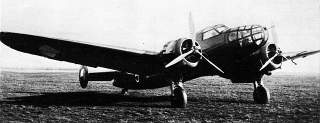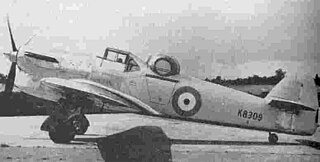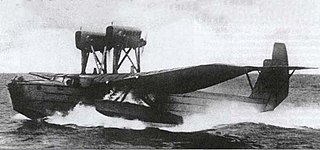
The Avro Lancaster is a British Second World War heavy bomber. It was designed and manufactured by Avro as a contemporary of the Handley Page Halifax, both bombers having been developed to the same specification, as well as the Short Stirling, all three aircraft being four-engined heavy bombers adopted by the Royal Air Force (RAF) during the same wartime era.

The Beechcraft XA-38 "Grizzly" was a World War II-era ground attack aircraft, developed by Beechcraft, but never put into production. The Grizzly was to have been fitted with a forward-firing 75 mm cannon, to penetrate heavily armored targets.
The LWS-6 Żubr was a Polish twin-engined medium bomber, produced by the LWS factory before World War II. It was produced in limited numbers and was used for training only, as it was inferior to the contemporary PZL.37 Łoś design.

The Bristol Type 163 Buckingham was a British Second World War medium bomber for the Royal Air Force (RAF). Overtaken by events, it was built in small numbers and was used primarily for transport and liaison duties.

The Bloch MB.130 and its derivatives were a series of French monoplane reconnaissance-bombers developed during the 1930s. They saw some limited action at the beginning of World War II but were obsolete by that time and suffered badly against the Luftwaffe. After the fall of France, a few were pressed into Luftwaffe service.

The MB.210 and MB.211 were the successors of the French Bloch MB.200 bomber built by Societé des Avions Marcel Bloch in the 1930s and differed primarily in being low wing monoplanes rather than high wing monoplanes.

The Aero A.300 was a Czechoslovak bomber aircraft that first flew in 1938 as a much refined development of the A.304.

The Boeing YB-40 Flying Fortress was a modification for operational testing purposes of the B-17 Flying Fortress bomber aircraft, converted to act as a heavily armed gunship to support other bombers during World War II. At the time of its development, long-range fighter aircraft such as the North American P-51 Mustang were just entering quantity production, and thus were not yet available to accompany bombers all the way from England to Germany and back.

The Ilyushin Il-6 was a Soviet long-range bomber developed from the Ilyushin Il-4 during 1942. Originally intended as a high-speed replacement for the Il-4, it was recast as a very long-range bomber with fuel-conserving diesel engines before production of the single prototype began in December 1942. Flight testing showed controllability issues when landing at high weights and the engines proved to be hard to start at low temperatures and were slow to respond to throttle movements. Further development was canceled in 1944.

The Ilyushin Il-30 was a Soviet turbojet-powered tactical bomber designed as a higher-performance, swept wing version of the Ilyushin Il-28, in the late 1940s. Its thin wing and engine nacelles necessitated the use of tandem landing gear, the first Soviet aircraft to do so. It was apparently canceled before the prototype made its first flight, although sources disagree with this.

The Short S.45 Seaford was a 1940s flying boat, designed as a long range maritime patrol bomber for RAF Coastal Command. It was developed from the Short S.25 Sunderland, and initially ordered as "Sunderland Mark IV".

The Hawker Hotspur was a Hawker Henley redesigned to take a Boulton-Paul semi-powered four gun turret. It was designed in response to Air Ministry Specification F.9/35, which required a powered turret as the main armament to replace the Hawker Demon.

The Beriev MBR-2 was a Soviet multi-purpose flying boat which entered service with the Soviet Navy in 1935. Out of 1,365 built, 9 were used by foreign countries including Finland and North Korea. In Soviet Union it sometimes carried the nickname of "Kорова" (cow) and "Амбар" (barn).

The Martin-Baker MB 2 was a British private-venture fighter prototype based on a simple basic structure that had been developed in the earlier MB 1 civil aircraft. Although briefly evaluated as a fighter by the Royal Air Force, the MB 2 was limited in design potential and never entered series production.

The Savoia-Marchetti SM.89 was an attack aircraft designed by Alessandro Marchetti and built by Savoia-Marchetti. Only one example was built, the prototype (MM.543).

The Caproni Ca.101 was a three-engine Italian airliner which later saw military use as a transport and bomber. It was designed in 1927 and first flown in 1928.

The ANT-8 was an experimental flying boat designed by Tupolev. It was designated the "MDR-2" by the military.

The Ilyushin Il-22, USAF/DOD designation Type 10, was the first Soviet jet-engined bomber to fly. It used four Lyulka TR-1 turbojets carried on short horizontal pylons ahead and below the wing. The engines did not meet their designed thrust ratings and their fuel consumption was higher than planned. These problems meant that the aircraft could not reach its required performance and it was cancelled on 22 September 1947.
The Latécoère 550 was a four-engined French seaplane, designed in the early 1930s as a bomber/torpedo bomber. Though initial handling problems were partly resolved, the aircraft was deemed too slow and did not go into production.
The Caproni Ca.134 was a biplane reconnaissance aircraft built by the Italian company Caproni in the 1930s.

















